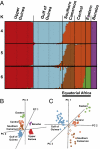Evidence from Cameroon reveals differences in the genetic structure and histories of chimpanzee populations
- PMID: 21368170
- PMCID: PMC3064329
- DOI: 10.1073/pnas.1015422108
Evidence from Cameroon reveals differences in the genetic structure and histories of chimpanzee populations
Abstract
The history of the genus Pan is a topic of enduring interest. Chimpanzees (Pan troglodytes) are often divided into subspecies, but the population structure and genetic history of chimpanzees across Africa remain unclear. Some population genetics studies have led to speculation that, until recently, this species constituted a single population with ongoing gene flow across its range, which resulted in a continuous gradient of allele frequencies. Chimpanzees, designated here as P. t. ellioti, occupy the Gulf of Guinea region that spans southern Nigeria and western Cameroon at the center of the distribution of this species. Remarkably, few studies have included individuals from this region, hindering the examination of chimpanzee population structure across Africa. Here, we analyzed microsatellite genotypes of 94 chimpanzees, including 32 designated as P. t. ellioti. We find that chimpanzees fall into three major populations: (i) Upper Guinea in western Africa (P. t. verus); (ii) the Gulf of Guinea region (P. t. ellioti); and (iii) equatorial Africa (P. t. troglodytes and P. t. schweinfurthii). Importantly, the Gulf of Guinea population is significantly different genetically from the others, sharing a last common ancestor with the populations in Upper Guinea ~0.46 million years ago (mya) and equatorial Africa ~0.32 mya. Equatorial chimpanzees are subdivided into up to three populations occupying southern Cameroon, central Africa, and eastern Africa, which may have constituted a single population until ~0.10-0.11 mya. Finally, occasional hybridization may be occurring between the Gulf of Guinea and southern Cameroon populations.
Conflict of interest statement
The authors declare no conflict of interest.
Figures




Similar articles
-
The population genetics of wild chimpanzees in Cameroon and Nigeria suggests a positive role for selection in the evolution of chimpanzee subspecies.BMC Evol Biol. 2015 Jan 21;15:3. doi: 10.1186/s12862-014-0276-y. BMC Evol Biol. 2015. PMID: 25608610 Free PMC article.
-
Chimpanzee population structure in Cameroon and Nigeria is associated with habitat variation that may be lost under climate change.BMC Evol Biol. 2015 Jan 21;15(1):2. doi: 10.1186/s12862-014-0275-z. BMC Evol Biol. 2015. PMID: 25608567 Free PMC article.
-
Why Are Nigeria-Cameroon Chimpanzees (Pan troglodytes ellioti) Free of SIVcpz Infection?PLoS One. 2016 Aug 9;11(8):e0160788. doi: 10.1371/journal.pone.0160788. eCollection 2016. PLoS One. 2016. PMID: 27505066 Free PMC article.
-
The sampling scheme matters: Pan troglodytes troglodytes and P. t. schweinfurthii are characterized by clinal genetic variation rather than a strong subspecies break.Am J Phys Anthropol. 2015 Feb;156(2):181-91. doi: 10.1002/ajpa.22638. Epub 2014 Oct 20. Am J Phys Anthropol. 2015. PMID: 25330245 Free PMC article.
-
On the tool use behavior of the bonobo-chimpanzee last common ancestor, and the origins of hominine stone tool use.Am J Primatol. 2014 Oct;76(10):910-8. doi: 10.1002/ajp.22284. Epub 2014 Apr 7. Am J Primatol. 2014. PMID: 24710771 Review.
Cited by
-
Biological races in humans.Stud Hist Philos Biol Biomed Sci. 2013 Sep;44(3):262-71. doi: 10.1016/j.shpsc.2013.04.010. Epub 2013 May 16. Stud Hist Philos Biol Biomed Sci. 2013. PMID: 23684745 Free PMC article.
-
Eco-geographical diversification of bitter taste receptor genes (TAS2Rs) among subspecies of chimpanzees (Pan troglodytes).PLoS One. 2012;7(8):e43277. doi: 10.1371/journal.pone.0043277. Epub 2012 Aug 16. PLoS One. 2012. PMID: 22916235 Free PMC article.
-
Y-Chromosome Structural Diversity in the Bonobo and Chimpanzee Lineages.Genome Biol Evol. 2016 Aug 3;8(7):2231-40. doi: 10.1093/gbe/evw150. Genome Biol Evol. 2016. PMID: 27358426 Free PMC article.
-
Similar patterns of genetic diversity and linkage disequilibrium in Western chimpanzees (Pan troglodytes verus) and humans indicate highly conserved mechanisms of MHC molecular evolution.BMC Evol Biol. 2020 Sep 15;20(1):119. doi: 10.1186/s12862-020-01669-6. BMC Evol Biol. 2020. PMID: 32933484 Free PMC article.
-
Environmental variability supports chimpanzee behavioural diversity.Nat Commun. 2020 Sep 15;11(1):4451. doi: 10.1038/s41467-020-18176-3. Nat Commun. 2020. PMID: 32934202 Free PMC article.
References
-
- Cohen J. In the shadow of Jane Goodall. Science. 2010;328:30–35. - PubMed
-
- Groves CP. Primate Taxonomy. Washington, D.C.: Smithsonian Institution; 2001.
-
- Oates JF, et al. Pan troglodytes. Switzerland: IUCN, Gland; 2010. IUCN Red List of Threatened Species. Version 2010.4. Available at www.iucnredlist.org. Accessed October 18, 2010.
-
- Fischer A, Pollack J, Thalmann O, Nickel B, Pääbo S. Demographic history and genetic differentiation in apes. Curr Biol. 2006;16:1133–1138. - PubMed
-
- Groves CP. Geographic variation within eastern chimpanzees. Australas Primatol. 2005;17:19–46.
Publication types
MeSH terms
Grants and funding
LinkOut - more resources
Full Text Sources

